
Recently on Cyclingnews.com |
Tech feature - July 19, 2006.
Campagnolo new 2007 groups - all 10-speed, all the time
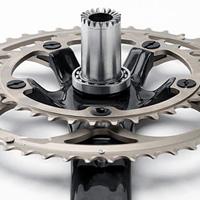
|
Campagnolo's new groups for 2007 will feature significant improvements across the board, from the high-end to the entry-level. For 2007, the Ultra-torque bottom bracket/crankset replaces the venerable square-taper design in all groups except for the low-end Xenon set. The other big design change is the Skeleton hollowed-arm brakes. John Kenny checks out special pre-release data on Campag's new gear for 2007.
The main Campagnolo changes for 2007 are focused around the bottom bracket, crankset and the brakes. Probably the most significant change is Campag's abandonment of the 'trickle down' policy where techological changes affect Record first and then filter down over the years to the cheaper groups.
The significant changes for 2007 are across the board. Or, as one distributor said to Cyclingnews, "about the only criticism we can make is that the lower-end groups are just too good". All groupsets are now available in 10-speed and all 2007 cranksets barring Xenon will have the Ultra-torque design and the new 'Skeleton' brakes will be included from Veloce upwards.
Ultra-torque system
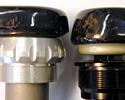
|
The Ultra-torque system, along with the Skeleton brakes, represents the biggest departure from conventional Campagnolo design. The old square-taper axle is gone after decades of faithful service and is replace with a combined bottom bracket/crankset system. The new system is lighter than Record 2006 and is significantly stiffer. According to Campagnolo, the Record and Chorus models are also torsionally stiffer than their main competitors. The 'Q-factor', the distance between the pedals, remains the same as on the old models. This is important to keep riders knees tracking properly.
Those who have tried fruitlessly to get the bearings out of some of the rival systems will be pleased to see the accessability of Campagnolo's outboard earings. They're easy and comparatively cheap to replace. Campagnolo also say that they last longer.
Skeleton brakes
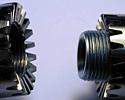
|
The Skeleton brakes are quite obviously going to be lighter than the previous design as sections of the arms have been carved out. It's a radically different looking system and has an almost retro appeal. Older readers will recall a time when riders would fastidiously carve and drill out sections of their components in the name of lightness. Unfortunately strength was normally compromised as well.
So how has Campagnolo maintained the integral strength of the brakes? Campagnolo conducted a study where data recorders were mounted to a bike to determine where the areas of greatest stress on the components. The component areas that had unnecessary bulk for the job they were doing were carved out. "That study gave life to the design of the Skeleton brakes which have increased rigidity at the points of greatest stress," said Campagnolo's Francesco Zenere, "while the material is lightened where there is no stress. This new design led to a reduction in weight and a gain in performance."
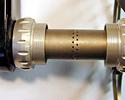
|
Campagnolo has also forged the brake arms rather than using CNC technology. According to Zenere, "Forging maintains the micro-crystalline structure of the aluminium alloy… and this is the main factor in the life of a component. This is not the case with CNC machining which, on the one hand, makes it possible to realise lighter components with attractive forms, [but] breaks the structure of the alloy and makes the component more vulnerable to the phenomena of cracking and breaking with fatigue."
Skeleton brakes maintain the differentiated design that the company has used since 2002. The single-pivot design of the rear brake saves weight and does not affect braking as the front brakes are responsible for most of the stopping power. The back brake is also less likely to lock under extreme braking with its single-pivot design. Campagnolo says that in another study it found that the new design was safer. "It was in fact noted that, as there was no risk of locking the rear wheel, the cyclist can act on both brakes without concern and stop the bike without the risk of dangerous swerving. This is the reason why all Skeleton brakes are of the differentiated type," said Zenere.
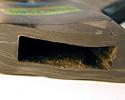
|
The 'Quick Shift' utilised on the Ergopower levers in the groups apparently helps shifting under load, while the new 'Escape' mechanism on the lower-end groups is a simpler set-up, thereby helping with maintenance. The Escape mechanism does not allow the multiple downshifts that are available with Chorus and Record. Centaur, Veloce, Mirage and Xenon users will be limited to two cog downshifts at a time.
Record
The flagship Record groups must share its changes with its lower-end brothers for the first time, but the main changes to Record make it lighter and more exotic than the others in the range. The Ultra-hollow crankset is unique to Record and Chorus. The other groups get the Ultra-torque part of the design, but get alloy crank arms and spiders. The new Record crankset is 89 grams lighter than last year's model. There is no longer an aluminium crankset option. The longer crank arm lengths of 177.5mm and 180mm are only available on the Record group.
The new Record Skeleton brakes are 33 grams lighter than the old model, with increased stopping power according to Campagnolo. The hubs have a combined weight that is 29 grams lighter than before.
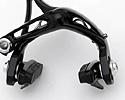
|
Chorus
The new Chorus crankset is 85 grams lighter than the previous model and is also no longer available in aluminium. The Skeleton brakes are 36 grams lighter, the Ergopower levers and derailleurs get the Quick Shift system and Chorus users will get Record hubs as part of the group. The ability to 'dump' down multiple gears in one hit will be available only to Record and Chorus users. The lower groups will change down by a maximum two cogs at a time.
Centaur
Centaur now gets a bit more carbon - on the Ergopower levers and the rear derailleur body. The levers are 70 grams lighter thanks to the use carbon and the simpler Escape mechanism (that also restricts multiple downshifts). The Ultra-Torque crankset is only available in aluminium, so the Chorus carbon has not trickled down a step.. Also new are the CNC-machined aluminium sprockets which Campagnolo say further enhances the shifting. The Ultra-Torque Centaur crankset is available with traditional and compact chainrings, nominally 39/53 and 34/50. Centaur also gets a new 11-25 cassette. The new combination is designed to complement compact crankset users as it provides broader range of ratios.

|
Veloce
Veloce gets the Ultra-torque and Skeleton parts and is available in two colours - a black finish and the impressively-named silver, 'Veloce Infinite'. The aluminium crankset will only be available as compact; with 39/53 or 34/50 chainrings. Veloce is the final group in the range to get the Skeleton brakes. The Ergopower levers are the Quick Shift type and are fitted with Campagnolo's simpler Escape mechanism. Veloce also gets the 11-25 cassette.
Mirage and Xenon
Mirage gets the new 10-speed flat bar Ergopower controls and is the final group to get the Ultra-torque crankset. The Ergo levers are 52 grams lighter than the previous version. The new Mirage hubs are also lighter by 100 grams. Xenon's crankset gets an ISO type bottom bracket and a compact drive-ready front derailleur. The Mirage and Xenon rear mechs are available in short, medium and long cage. The Xenon group will use Mirage's brakes, hubs, sprockets and Quick Shift front derailleurs and Veloce's chain.
Triple groups

|
The triple groups are now completely separate to the double groups and are re-named Race, Comp and Champ. All three groups use ISO type bottom brackets, have 170 or 175 mm crank arms and typically are supplied with 30-42-52 chainrings. The triple groups use the 111 or 115.5mm Mirage bottom brackets.
Electronic shifting?
The electronic shifting derailleurs that have been in development for the past four year are still a while away from mass-production. Campagnolo Australia's national sales manager, Jonathon Nunan, said that he is often asked when the electronic parts will become available, "Many people ask me why they haven't released it yet when they've seen it being used in the Pro races, and in fact has already won some major races? Well, in true Campagnolo form, they won't release anything until it's 100 percent developed and proven. Part of that is longitudinal testing that they insist on."

|
Campagnolo trades on its reputation for reliability and quality, something that could be compromised if they released an electronic group that had not been properly tested, "What Campagnolo don't want, is something that develops problems after thousands of kilometres or years of race-level usage. After all, Campy is famous for its reliability and dependability, and there are just too many potential pitt-falls when it comes to this kind of technology," said Nunan.
The other major delay for the Campagnolo electronic parts, is changing and improving battery technology, with which Campagnolo is struggling to keep up. "As the long-life batteries get smaller and lighter, Campagnolo are constantly redesigning their components and systems to facilitate these new batteries," said Nunan. "When Campagnolo come to the market with electronic, they want it to be functionally attractive, but also appealing from a weight point of view. No matter how clever, it won't be taken up it is heavier than a conventional gruppo."
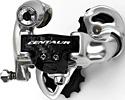
|
Campagnolo's electronic
group V2.0
Eeckhout wins on Campagnolo Electric
More Campagnolo Electronic
Bikes of Paris-Roubaix
2005
Campagnolo's test pilot
Photography
For a thumbnail gallery of these images, click here
Images by Campagnolo
- Record Ultra-hollow crankset with 53/39 chainrings.
- Record Ultra-torque bottom bracket shell from the inside.
- Record crankset with 53/39 chainrings.
- Record compact crankset with 50/34 chainrings.
- Ultra-torque bottom bracket shell close up.
- The Ultra-torque bottom bracket shell uses splined teeth to lock together.
- The splined teeth of the bottom bracket shell.
- The two halves of the bottom bracket shell lock together.
- 10mm locknut for the bottom bracket.
- 42 Nm of torque is required to lock the bottom bracket to the crankset.
- Right side bearing cup with Italian thread of course!
- Bearing cup with surclip.
- The complete system , Record crankset and Ultra-torque bottom bracket.
- The left side bottom bracket bolt uses a hefty 10 mm Allen key.
- Record Ultra-hollow crank arm sliced staight across.
- Threaded carbon on the Record Ultra-hollow crank arm.
- Record Ultra-hollow crank arm cross-section.
- Record Skeleton brakes leave little room for labelling.
- Record Skeleton brakes are 33 grams lighter than the old ones.
- Record hubs are 29 grams lighter than the old hubs.
- Record double front derailleur with carbon front.
- Record triple front derailleur with carbon front.
- Record Ergopower levers use the 'Quick shift' system.
- Chorus carbon crankset. The aluminium version is now discontinued.
- New Chorus compact-drive crankset.
- Chorus Skeleton brakes are 36 grams lighter than the old brakes.
- Chorus Skeleton brakes with large cut-out sections.
- Campagnolo Record hubs.
- The Chorus front derailleur uses the 'Quick shift' mechanism.
- The Chorus triple front derailleur uses the 'Quick shift' mechanism.
- Chorus 'Quick shift' Ergopower levers
- New Comp triple crankset uses ISO type bottom bracket.
- Comp triple front derailleur.
- Comp triple rear derailleur.
- The Centaur crankset is the top aluminium offering from Campag.
- Centaur Compact drive crankset.
- The new Centaur Ergo levers are 70 grams lighter than the old ones.
- The Centaur rear derailleur gets a carbon plate.
- Centaur 10-speed double front derailleur.
- Centaur 10-speed triple front derailleur.
- Centaur Skeleton brakes.
- Centaur hubs.
- Veloce Ultra-torque crankset.
- Veloce Skeleton brakes. The fourth-in-line gruppo gets the new brakes.
- Veloce 10-speed double front derailleur.
- Veloce 10-speed triple front derailleur.
- Veloce Ergopower lever.
- Veloce hubs.
- New Race triple crankset uses ISO type bottom bracket.
- New 10-speed Race triple long cage rear derailleur.
- New Race triple 'Quick Shift' front derailleur.
- Mirage rear derailleur.
- The Ultra-torque system filters down as far as Mirage.
- 10 speed flat bar shifters.
- Xenon rear derailleur.
- Xenon Ergopower shifters.
- Mirage hubs.
- New Comp triple crankset uses an ISO type bottom bracket.
- New Comp triple 'Quick Shift' front derailleur.
- New Comp triple long cage rear derailleur.
- Khamsin front wheel with black finish.
- Khamsin rear wheel with black finish.
- Khamsin front wheel with gold finish.
- Khamsin rear wheel with gold finish.
- Vento rear wheel with black finish.
- Scirocco rear wheel with black finish.
- Chorus crankset with the ultra-torque bottom bracket shell.
- The old and the new bottom bracket systems.

